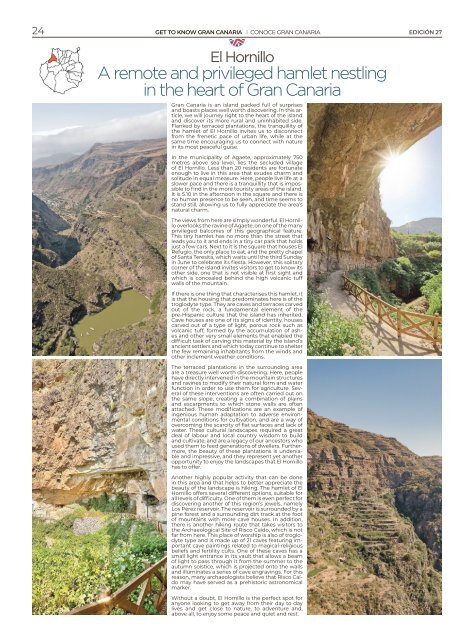No. 27 - Its Gran Canaria Magazine
Rutas, recomendaciones y noticias de Gran Canaria. Routes, tips and news about Gran Canaria.
Rutas, recomendaciones y noticias de Gran Canaria.
Routes, tips and news about Gran Canaria.
Create successful ePaper yourself
Turn your PDF publications into a flip-book with our unique Google optimized e-Paper software.
24<br />
GET TO KNOW GRAN CANARIA I CONOCE GRAN CANARIA EDICIÓN <strong>27</strong><br />
El Hornillo<br />
A remote and privileged hamlet nestling<br />
in the heart of <strong>Gran</strong> <strong>Canaria</strong><br />
<strong>Gran</strong> <strong>Canaria</strong> is an island packed full of surprises<br />
and boasts places well worth discovering. In this article,<br />
we will journey right to the heart of the island<br />
and discover its more rural and uninhabited side.<br />
Flanked by terraced plantations, the tranquillity of<br />
the hamlet of El Hornillo invites us to disconnect<br />
from the frenetic pace of urban life, while at the<br />
same time encouraging us to connect with nature<br />
in its most peaceful guise.<br />
In the municipality of Agaete, approximately 750<br />
metres above sea level, lies the secluded village<br />
of El Hornillo. Less than 20 residents are fortunate<br />
enough to live in this area that exudes charm and<br />
solitude in equal measure. Here, people live life at a<br />
slower pace and there is a tranquillity that is impossible<br />
to find in the more touristy areas of the island.<br />
It is 5.10 in the afternoon in the square and there is<br />
no human presence to be seen, and time seems to<br />
stand still, allowing us to fully appreciate the area’s<br />
natural charm.<br />
The views from here are simply wonderful. El Hornillo<br />
overlooks the ravine of Agaete, on one of the many<br />
privileged balconies of this geographical feature.<br />
This tiny hamlet has no more than the street that<br />
leads you to it and ends in a tiny car park that holds<br />
just a few cars. Next to it is the square that houses El<br />
Refugio, the only place to eat, and the pretty chapel<br />
of Santa Teresita, which waits until the third Sunday<br />
in June to celebrate its fiesta. However, this solitary<br />
corner of the island invites visitors to get to know its<br />
other side, one that is not visible at first sight and<br />
which is concealed behind the high volcanic tuff<br />
walls of the mountain.<br />
If there is one thing that characterises this hamlet, it<br />
is that the housing that predominates here is of the<br />
troglodyte type. They are caves and terraces carved<br />
out of the rock, a fundamental element of the<br />
pre-Hispanic culture that the island has inherited.<br />
Cave houses are one of its signs of identity, houses<br />
carved out of a type of light, porous rock such as<br />
volcanic tuff, formed by the accumulation of ashes<br />
and other very small elements that enabled the<br />
difficult task of carving this material by the island’s<br />
ancient settlers and which today continue to shelter<br />
the few remaining inhabitants from the winds and<br />
other inclement weather conditions.<br />
The terraced plantations in the surrounding area<br />
are a treasure well worth discovering. Here, people<br />
have directly intervened in the mountain structures<br />
and ravines to modify their natural form and water<br />
function in order to use them for agriculture. Several<br />
of these interventions are often carried out on<br />
the same slope, creating a combination of plains<br />
and escarpments to which stone walls are often<br />
attached. These modifications are an example of<br />
ingenious human adaptation to adverse environmental<br />
conditions for cultivation, and are a way of<br />
overcoming the scarcity of flat surfaces and lack of<br />
water. These cultural landscapes required a great<br />
deal of labour and local country wisdom to build<br />
and cultivate, and are a legacy of our ancestors who<br />
used them to feed generations of dwellers. Furthermore,<br />
the beauty of these plantations is undeniable<br />
and impressive, and they represent yet another<br />
opportunity to enjoy the landscapes that El Hornillo<br />
has to offer.<br />
Another highly popular activity that can be done<br />
in this area and that helps to better appreciate the<br />
beauty of the landscape is hiking. The hamlet of El<br />
Hornillo offers several different options, suitable for<br />
all levels of difficulty. One of them is even perfect for<br />
discovering another of this region’s jewels, namely<br />
Los Pérez reservoir. The reservoir is surrounded by a<br />
pine forest and a surrounding dirt track at the foot<br />
of mountains with more cave houses. In addition,<br />
there is another hiking route that takes visitors to<br />
the Archaeological Site of Risco Caído, which is not<br />
far from here. This place of worship is also of troglodyte<br />
type and is made up of 21 caves featuring important<br />
cave paintings related to magical-religious<br />
beliefs and fertility cults. One of these caves has a<br />
small light entrance in its vault that allows a beam<br />
of light to pass through it from the summer to the<br />
autumn solstice, which is projected onto the walls<br />
and illuminates a series of cave engravings. For this<br />
reason, many archaeologists believe that Risco Caído<br />
may have served as a prehistoric astronomical<br />
marker.<br />
Without a doubt, El Hornillo is the perfect spot for<br />
anyone looking to get away from their day to day<br />
lives and get close to nature, to adventure and,<br />
above all, to enjoy some peace and quiet and rest.
















